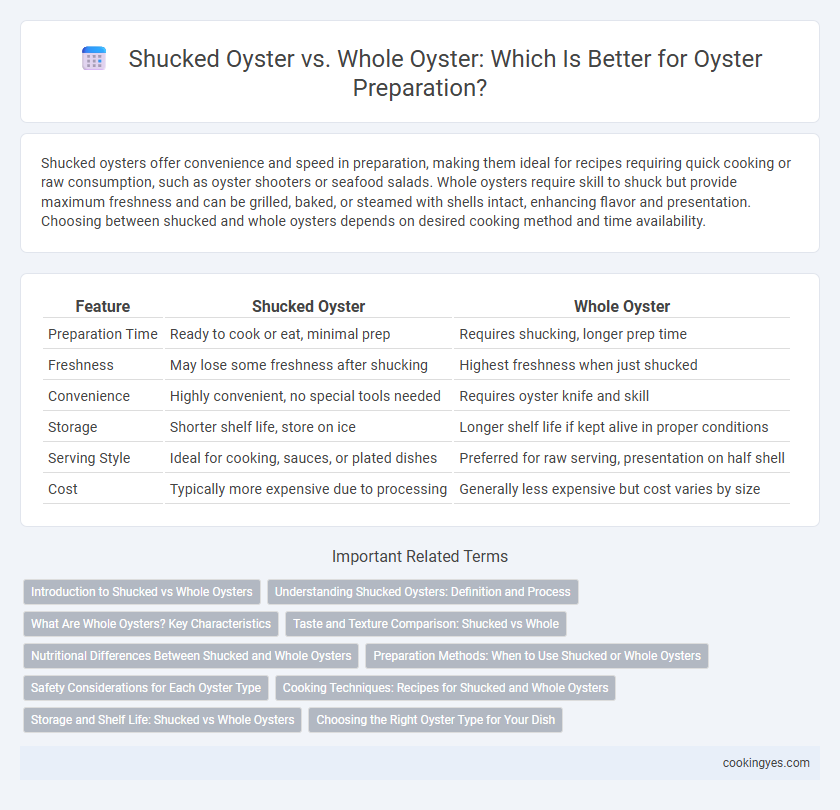Shucked oysters offer convenience and speed in preparation, making them ideal for recipes requiring quick cooking or raw consumption, such as oyster shooters or seafood salads. Whole oysters require skill to shuck but provide maximum freshness and can be grilled, baked, or steamed with shells intact, enhancing flavor and presentation. Choosing between shucked and whole oysters depends on desired cooking method and time availability.
Table of Comparison
| Feature | Shucked Oyster | Whole Oyster |
|---|---|---|
| Preparation Time | Ready to cook or eat, minimal prep | Requires shucking, longer prep time |
| Freshness | May lose some freshness after shucking | Highest freshness when just shucked |
| Convenience | Highly convenient, no special tools needed | Requires oyster knife and skill |
| Storage | Shorter shelf life, store on ice | Longer shelf life if kept alive in proper conditions |
| Serving Style | Ideal for cooking, sauces, or plated dishes | Preferred for raw serving, presentation on half shell |
| Cost | Typically more expensive due to processing | Generally less expensive but cost varies by size |
Introduction to Shucked vs Whole Oysters
Shucked oysters are those removed from their shells, offering convenience and immediate usability in recipes, while whole oysters require manual shucking before consumption or cooking. The processing of shucked oysters ensures they are cleaned and inspected, making them ideal for dishes where texture and ease are prioritized. Whole oysters maintain freshness longer and provide a traditional experience but demand skill and tools for shucking before use in culinary preparations.
Understanding Shucked Oysters: Definition and Process
Shucked oysters refer to oysters that have been removed from their shells through a careful process to preserve their freshness and texture, making them ready to eat or cook. The shucking process involves using a specialized knife to pry open the oyster shell and extract the oyster meat, which requires skill to avoid damaging the delicate flesh. Compared to whole oysters, shucked oysters offer convenience for recipes like seafood stews, raw bars, and oyster stuffing, eliminating the need for on-the-spot shell opening.
What Are Whole Oysters? Key Characteristics
Whole oysters consist of the entire bivalve, including the shell and the intact meat inside, preserving freshness and flavor during storage and preparation. Their key characteristics include a hard, rough exterior shell that protects the soft, briny oyster meat, which must be shucked before consumption or cooking. Chefs often prefer whole oysters for grilling, baking, or serving raw on the half shell to maintain the oyster's natural juices and enhance taste.
Taste and Texture Comparison: Shucked vs Whole
Shucked oysters offer a briny, concentrated flavor with a smooth, creamy texture perfect for immediate consumption or recipes needing quick preparation. Whole oysters retain more natural juices, providing a fresher, slightly metallic taste with a firmer, chewier texture that enhances sensory experience when eaten raw or lightly cooked. Taste intensity and texture vary depending on handling, making shucked oysters ideal for controlled flavor dishes, while whole oysters deliver a robust, authentic ocean essence.
Nutritional Differences Between Shucked and Whole Oysters
Shucked oysters contain slightly fewer calories and minerals compared to whole oysters due to the removal of the shell and liquid, which holds essential nutrients like zinc and iron. Whole oysters retain their natural briny liquid, providing a richer source of vitamins such as B12 and omega-3 fatty acids. Choosing whole oysters ensures maximum intake of marine-derived nutrients crucial for immune function and heart health.
Preparation Methods: When to Use Shucked or Whole Oysters
Shucked oysters are ideal for recipes requiring quick cooking or incorporation into dishes like stews, chowders, and seafood salads, as they are pre-opened and cleaned, saving preparation time. Whole oysters are preferred for grilling, baking, or steaming, allowing for enhanced flavor retention and presentation by cooking them in their natural shells. Choosing between shucked and whole oysters depends on the cooking method and desired texture, with whole oysters suited for heat-intensive methods and shucked oysters for rapid or mixed preparations.
Safety Considerations for Each Oyster Type
Shucked oysters require rigorous processing and refrigeration to prevent bacterial contamination, making them safer for immediate consumption but necessitating strict handling protocols. Whole oysters maintain their protective shell until shucking, reducing exposure to pathogens, yet improper shucking techniques can introduce safety risks such as cuts and shell fragments. Ensuring minimal time between shucking and consumption alongside proper storage temperatures is critical for both oyster types to mitigate foodborne illness risks.
Cooking Techniques: Recipes for Shucked and Whole Oysters
Shucked oysters offer versatility for cooking techniques such as grilling, frying, and incorporating into sauces or stews, delivering a tender texture and concentrated briny flavor. Whole oysters are ideal for roasting, steaming, or baking in the shell, which preserves moisture and enhances their natural taste through gentle heat. Recipes like oyster Rockefeller highlight whole oysters baked with herbs and cheese, while shucked oysters excel in recipes like oyster stew or tempura, emphasizing their tender, accessible meat.
Storage and Shelf Life: Shucked vs Whole Oysters
Shucked oysters require refrigeration at temperatures below 40degF and typically have a shelf life of 5 to 7 days when stored in airtight containers to maintain freshness. Whole oysters, stored in their shells and kept in a cool, humid environment between 35degF and 40degF, can last up to 2 weeks due to their natural protective barrier. Proper storage significantly impacts the quality and safety of oysters, with whole oysters generally offering longer shelf life compared to shucked varieties.
Choosing the Right Oyster Type for Your Dish
Selecting shucked oysters versus whole oysters depends on the dish's preparation and desired flavor. Shucked oysters provide convenience and immediate use for recipes like stews, seafood casseroles, or raw presentations, retaining the oyster's briny taste without shell handling. Whole oysters, ideal for grilling or steaming, offer a fresh, intense flavor and the interactive experience of opening the shell at the table, enhancing both taste and meal presentation.
Shucked Oyster vs Whole Oyster for preparation Infographic

 cookingyes.com
cookingyes.com